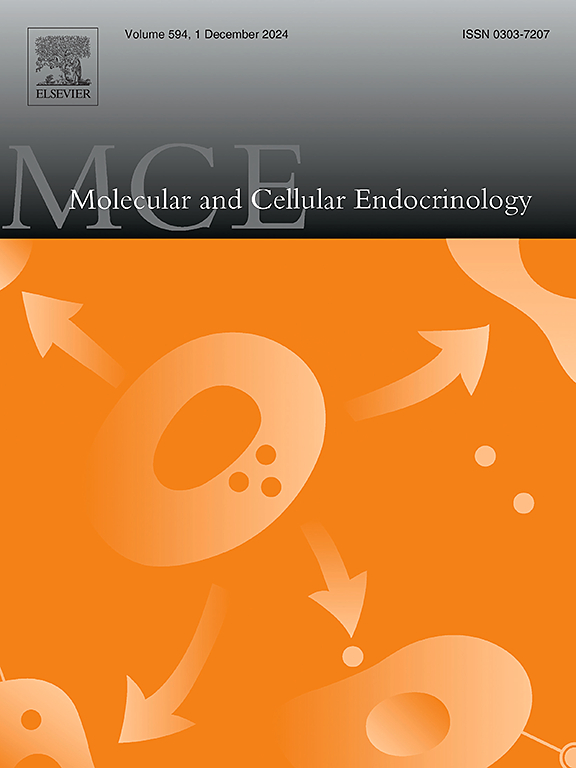夜间光照和高果糖摄入对大鼠中央生物钟和内分泌输出的相互作用
IF 3.6
3区 医学
Q2 CELL BIOLOGY
引用次数: 0
摘要
光污染是一个日益增加的全球环境风险因素,有助于最近代谢性疾病的负担。潜在的机制尚不清楚,但可能涉及生理和行为过程的昼夜节律控制的中断。时间中断的负面影响可以通过共同暴露于高能量摄入而增强。因此,我们研究了夜间人造光(ALAN)和饮用水中10%果糖对雄性大鼠下丘脑视交叉上核(SCN)中央时钟和昼夜节律激素输出的单独和联合影响。经过10周的ALAN暴露和高果糖摄入后,SCN中的时钟机制减弱,核心时钟基因Per1的昼夜差异被消除。此外,ALAN抑制了γ -氨基丁酸合成酶(GAD65)的日常变异性和果糖诱导的上调,潜在地影响了SCN中的抑制性神经传递。ALAN和果糖共同抑制血浆褪黑激素水平,揭示了过量果糖摄入是一种可以被ALAN增强的时间干扰因素。与褪黑素相比,高果糖增加了白天血浆睾酮浓度,并被ALAN抑制。此外,高果糖摄入提高了血浆中两种脂肪因子,瘦素和脂联素的水平,但在暴露于ALAN的大鼠中,这种反应在白天特异性地缺失,这表明ALAN降低了脂肪组织的反应性。我们的研究结果记录了ALAN和高果糖摄入对内分泌控制机制的复杂影响,这可能对代谢健康产生长期的负面影响。本文章由计算机程序翻译,如有差异,请以英文原文为准。
Interactive effects of light at night and high fructose intake on the central circadian clock and endocrine outputs in rats
Light pollution is an increasing global environmental risk factor that contributes to the recent burden of metabolic diseases. The underlying mechanisms are not understood, but disruption of circadian control of physiological and behavioural processes may be involved. The negative consequences of chronodisruption can be augmented by co-exposure to high energy intake. Therefore, we investigated the individual and combined effects of artificial light at night (ALAN) and 10 % fructose in drinking water on the central clock in the suprachiasmatic nuclei (SCN) of the hypothalamus and circadian hormonal outputs in male rats. After 10 weeks of ALAN exposure and high fructose intake, the clockwork in the SCN was attenuated as indicated by eliminated day/night differences in the core clock gene Per1. Additionally, ALAN suppressed the daily variability and fructose induced upregulation of a gamma-aminobutyric acid–synthesising enzyme (GAD65), potentially affecting inhibitory neurotransmission in the SCN. ALAN and fructose additively inhibited plasma melatonin levels revealing excessive fructose intake as a chronodisruptive factor that can be potentiated by ALAN. In contrast to melatonin, daytime plasma testosterone concentrations were increased by high fructose and supressed by ALAN. Furthermore, high fructose intake elevated the plasma levels of two adipokines, leptin and adiponectin, but this response was absent specifically during the daytime in rats exposed to ALAN, indicating that ALAN reduced adipose tissue responsiveness. Our results document the complex consequences of ALAN and high fructose intake on endocrine control mechanisms that can have a long-term negative impact on metabolic health.
求助全文
通过发布文献求助,成功后即可免费获取论文全文。
去求助
来源期刊

Molecular and Cellular Endocrinology
医学-内分泌学与代谢
CiteScore
9.00
自引率
2.40%
发文量
174
审稿时长
42 days
期刊介绍:
Molecular and Cellular Endocrinology was established in 1974 to meet the demand for integrated publication on all aspects related to the genetic and biochemical effects, synthesis and secretions of extracellular signals (hormones, neurotransmitters, etc.) and to the understanding of cellular regulatory mechanisms involved in hormonal control.
 求助内容:
求助内容: 应助结果提醒方式:
应助结果提醒方式:


